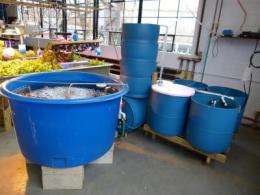New integrated building model may improve fish farming operations

Today's "locavore" movement with its emphasis on eating more locally-produced food is a natural fit for fruits and vegetables in nearly every region, but few entrepreneurs have dared to apply the concept to fish farming. Those who have ventured to turn a vacant barn or garage into an aquaculture business have too often been defeated by high energy and feed costs, building-related woes and serious environmental problems, says aquaculture researcher Andy Danylchuk at the University of Massachusetts Amherst.
Now he and colleagues are melding building design, fish ecology and aquaculture engineering techniques are melded into a first-of-its-kind building-integrated aquaculture (BIAq) model to offer an affordable, more holistic and sustainable approach to indoor fish production located close to markets and able to succeed even in cold climates. Their ideas are outlined in the current issue of ASHRAE Journal, published by the American Society of Heating, Refrigerating and Air-Conditioning Engineers.
As Danylchuk explains, typically when a small-scale entrepreneur starts up an aquaculture operation, he or she installs tanks and plumbing in an old chicken barn, for example. "But that's like building a house with no regard for the occupants' comfort or their utility budget," he says. In fact, studies show over 75 percent of total energy demands in the United States are due to building operations.
"Our team began looking at renewable energy systems to make power more affordable, and how fish farm waste streams can become plant food rather than an environmental headache. If you start by taking the building into consideration, these operations might actually become economically feasible," the fish ecologist adds.
The need for local aquaculture is clear, he and fellow UMass Amherst Building-Integrated Aquaculture Working Group members James Webb and green building expert Simi Hoque point out. Due to declining wild fish stocks and environmental degradation, fish farms now account for nearly 40 percent of the world's total fisheries production and it's growing.
Further, "while per capita seafood consumption has already reached record levels in the United States, recent USDA recommendations suggest more than twice this amount for a healthy lifestyle. Achieving this goal represents a significant challenge considering approximately 85 percent of U.S. seafood is imported and nearly half of this comes from overseas aquaculture production." These imports are tainted by food security and quality issues as well as considerable environmental drawbacks and financial costs of global transportation.
The BIAq team therefore set out to design a practical model for small businesses to help them produce good quality, local seafood with a modest investment of cash, low energy use, low greenhouse gas emissions, low waste/environmental damage and at prices consumers can afford. Their model dovetails systems to maximize energy efficiency and aquaculture operations by simultaneously addressing humidity, condensation, airflow, water flow, waste stream recovery, passive and renewable energy and worker health and safety.
For example, the BIAq model calls for recirculating fish tank wastewater through a step-wise filter system to remove waste and food residue and re-use the dissolved carbon, nitrogen and phosphorous nutrients as fertilizer in a hydroponic garden. In this way, wastewater is cleaned and recirculated back to the fish, while supporting a cash-crop such as herbs or garden greens attractive to consumers, and diverting wastewater from the environment.
Using a solar water-heating system can dramatically cut energy costs, as well. Another synergistic benefit can be gained by using heat pumps and exchangers, package refrigeration and condensation units to complement each other in controlling humidity and warming the atmosphere in an operation that is water-vapor intensive. Even small changes such as locating supply air ducts to the ceiling to allow air to move over interior walls helps to prevent moisture accumulation and mitigate high humidity, the authors point out.
"We identify areas where a BIAq approach might increase efficiency and reduce operating costs. Our focus is on processes and design decisions that have the greatest potential for energy conservation in the heavily populated temperate regions of the world." They add, "Climate control is a major challenge for indoor recirculating aquaculture systems, and continuing to ignore the design of the building envelope will result in inefficiencies and higher costs."
The authors hope that framing the development of recirculating aquaponics facilities as a holistic and synergistic systems-based endeavor will enable a robust analysis of the environmental, social and economic benefits that will make fish production more sustainable.
Provided by University of Massachusetts at Amherst

















